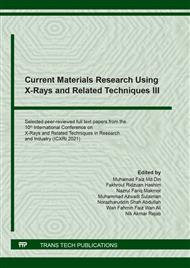[1]
M. Meybeck, R. Helmer, The Quality of Rivers: From pristine stage to Global Pollution, Glob. Planet. Change. 1(4) (1989) 283–309.
DOI: 10.1016/0031-0182(89)90191-0
Google Scholar
[2]
A. Hajali, COD and TOC Removal Assessment in Effluent from Anaerobic Bioreactor and Effluent from Cyclic Ozonation-Biotreatment in A Pulp Factory Wastewater Treatment, 4th International Conference on Energy, Environment and Sustainable Development at Pakistan, (2016).
DOI: 10.1109/ciem.2017.8120786
Google Scholar
[3]
G. Kirbria, Environmental Update-Dissolved Oxygen: The Facts, Outlet. 162 (2004) 2-4.
Google Scholar
[4]
C. Assmann, A. Scott, D. Biller, Online Total Organic Carbon (TOC) Monitoring for Water and Wastewater Treatment Plants Processes and Operations Optimization. Drink. Water Eng. Sci. 10(2) (2017) 61-68.
DOI: 10.5194/dwes-10-61-2017
Google Scholar
[5]
E. Amanatidou, E. Trikoilidou, G, Samiotis, N.P Benetis, N. Taousanidis, An Easy Uncertainty Evaluation of the COD Titrimetric Analysis in Correlation with Quality Control and Validation Data. Method Applicability Region, Anal. Methods. 4(12) (2012) 4204-4212.
DOI: 10.1039/c2ay25687h
Google Scholar
[6]
P.T. Nguyen, T.H. Dao, Study on modelling fish processing wastewater anaerobic treatment, Asean Eng J Part C. 4(3) (2015) 6-15.
Google Scholar
[7]
M.Z. Mohd Alias, R. Mohd Ghazi, N.R. Nik Yusoff, M.H. Jamaludin, The Efficiency of Bamboo Activated Carbon for Removal of COD from Fish Cracker Industry Wastewater via Response Surface Methodology (RSM), IOP Conf. Ser.: Earth Environ. Sci. 549 (2020) 012058.
DOI: 10.1088/1755-1315/549/1/012058
Google Scholar
[8]
C.P. Goh, R. Mohd Ghazi, N.R. Nik Yusoff, M.Z. Mohd Alias, M. Jani. Adsorption of COD in wastewater by Activated Carbon from Rice Husk. IOP Conf. Ser.: Earth Environ. Sci. (2020) 596 (1) 012063.
DOI: 10.1088/1755-1315/596/1/012063
Google Scholar
[9]
B. Viswanathan, P. Neel, T. Varadarajan, Methods of activation and specific applications of carbon materials, first ed., Chennai, India, (2009).
Google Scholar
[10]
C. Correa Rodriguez, T. Otto, A. Kruse, Influence of the biomass components on the pore formation of activated carbon, Biomass Bioenerg. 97 (2017) 53–64.
DOI: 10.1016/j.biombioe.2016.12.017
Google Scholar
[11]
J. Rosas, J.R.M.J. Bedia, T. Cordero, HEMP-Derived Activated Carbon Fibers by Chemical Activation with Phosphoric Acid, Fuel. 88(1) (2009) 19-26.
DOI: 10.1016/j.fuel.2008.08.004
Google Scholar
[12]
T.H. Liou, S.J. Wu, Characteristics of microporous/mesoporous carbons prepared from rice husk under base-and acid-treated conditions, J. Hazard. Mater. 171(1) (2009) 693-703.
DOI: 10.1016/j.jhazmat.2009.06.056
Google Scholar
[13]
H. Patel, R. Vashi, Characterization and column adsorptive treatment for COD and color removal using activated neem leaf powder from textile wastewater, J. Urban Environ. Eng. 9(1) (2014) 45-53.
DOI: 10.4090/juee.2015.v9n1.045053
Google Scholar
[14]
N. Kannan, R. Jeya Ganesh, Studies on the removal of malachite green from aqueous solutions by mixed adsorbent, Indian J. Environ. Prot. 21 (2001) 127-133.
Google Scholar
[15]
Y. Pan, Y. Zhu, Z. Xu, R. Lu, Z. Zhang, M. Liang, H. Liu, Adsorption removal of COD from wastewater by the activated carbons prepared from sugarcane bagasse, The 5th International Conference on Bioinformatics and Biomedical Engineering at Guilin, P. R. China, (2011).
DOI: 10.1109/icbbe.2011.5781097
Google Scholar


